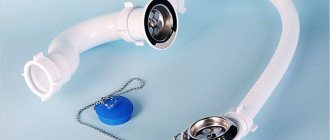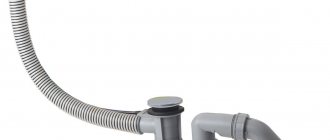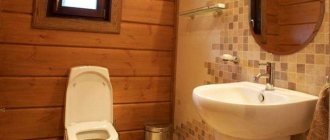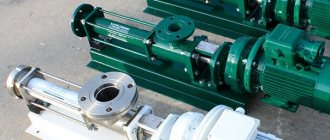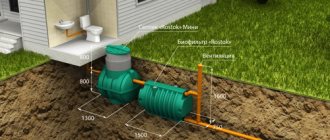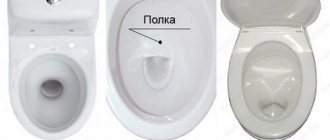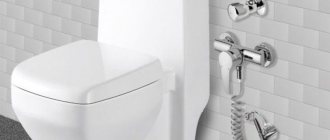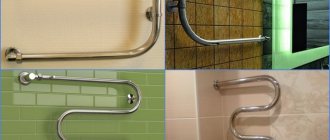Siphon is the main element of a plumbing connection, designed to drain water into the sewer riser. In addition, the siphon provides protection against blockages and also acts as a barrier that prevents sewer odors from entering the room. In this article we will tell you about all types of siphons, how to select, assemble and replace them.
What is a siphon
A siphon is a special device consisting of one or more pipes and containers and is used to connect plumbing fixtures to wastewater disposal systems. Thanks to its design and bends, it creates a plug between the sewer and the room that is impenetrable for air exchange, preventing the penetration of odors and bacteria into the room.
Siphons are used in various rooms, including a kitchen, bathroom, shower stall. They differ from each other in structure, material and drainage overlap, and size. Despite the differences, all types have a similar structure of the main parts, including:
- Frame;
- Pipes;
- Drain;
- Bends;
- Connecting nuts and screws;
- Seals for sealing.
Design characteristics of semi-automatic
The semi-automatic bath fitting has a rather complex design, which is characterized by an additional shut-off valve controlled by a lever on the overflow hole. It can be made in the form of a button, a decorative valve, or a rotary ring. Control occurs using a system of cables and other additional connecting parts. The advantages of such a siphon lie primarily in convenience and comfort of use. The closed overflow device has a high aesthetic appeal.
On the other hand, the complexity of the design and the presence of many moving parts reduce the reliability of such systems.
When purchasing siphons of this type, it is important to pay special attention to manufacturers of high-quality fittings for sanitary equipment that have proven themselves well. The durability and uninterrupted operation of these drains directly depends on this.
How to choose a siphon
Siphon manufacturers use several terms to refer to sinks:
- A washbasin is another name for a sink, a bowl-shaped device designed for washing hands;
- Tulip is the name given to a sink with a faience floor stand;
- The sink is the most common name for a kitchen sink. They are distinguished by an enlarged drain hole. This means that quite large food waste can go down the drain from the kitchen sink. Or the consumer may want to place the disposer waste in the sink.
For a general understanding, we will combine all these names into one - shell.
To make a decision on buying a siphon you need to know:
- Diameter of the sink drain hole;
- Is there an additional hole in the sink to prevent overflow?
- Round or square overflow hole;
- Do you need an additional hole to connect a washing machine or dishwasher?
- What diameter of the sewer pipe is provided for connecting the siphon.
By answering these questions, you can easily select the necessary siphon for your sink. Let's go in order.
Drain hole diameter
You can compare the diameter of the drain hole with the siphon using the table:
| Diameter of the drain hole in the sink, mm | Designation of the required siphon |
| 90-94 | 3 1/2″ |
| 42-48 mm | 1 1/2 |
An overflow is a hole in the top of the sink that protects the owner from flooding if, for example, he left the water on and closed the drain hole. It can be built into the sink. For example, in porcelain sinks, the overflow hole directly in the porcelain mass is connected to the drain hole by a special channel.
Figure 1. Sink with built-in overflow
Fig 2. Sink with overflow
Overflow hole shape
There are two types of holes: square and round. You just need to look at the shape of the hole on the sink and choose a siphon with the same overflow shape.
Some manufacturers (for example Unicorn) supply siphons with overflow of two types in a set (Fig. 3). Accordingly, one is installed, the second is sent to the trash.
Fig 3. Square and round overflow in one set
Hole for connecting a washing machine or dishwasher
This question is simple. Either the machine needs to be connected to a siphon, or it doesn’t. All manufacturers write what additional holes they have. If you need to connect both a washing machine and a dishwasher, then there are siphons with two hooks for connecting them.
If you bought a siphon with a hole for connecting a washing machine or dishwasher, but you didn’t need it, then you don’t need to worry. You can safely use a siphon without connecting these holes. The structure of the beak for connecting the machine is made specifically to avoid leaks. Some manufacturers include plugs for extra holes in the kit.
Sewage pipe diameter
Everything is simple here too. In Russia, pipes with a diameter of 40mm or 50mm are most often used to connect sinks. Accordingly, at the end of the siphon name there is a designation of the connection diameter. If you have a 40 mm pipe, you choose a siphon with the designation 40. Sometimes, from siphon manufacturers you can find the designation 40/50. This means that the kit includes a universal corrugation with a connection diameter of 40 or 50 mm. In case you need a 50mm connection, you simply insert the end of the corrugated pipe into the sewer pipe. If you have a sewer outlet with a diameter of 40 mm, you simply cut off the end of the corrugated pipe (50 mm in diameter) just below the step and get a pipe with a diameter of 40 mm.
In European countries and less often in Russia, you can also find pipes with a 32 mm connection. Most often, this connection diameter is for siphons with an outlet size of 1 ¼. These parameters are also indicated in the name of the siphon from any manufacturer.
It is worth writing separately about the location of the sewer pipe to which the siphon is connected. After all, it can come out both from their walls and from the floor. In the case of using flexible corrugated pipe, this does not matter much. You can connect from any location. If you are a supporter of rigid pipe connections, then it is important to focus on this when choosing a siphon and select it with the desired connection.
There is also a small nuance regarding the length of the screw used in the siphon. Some manufacturers write screw parameters, and some do not. The screw in the siphon connects (or rather tightens) the upper cup with a mesh located in the sink drain with the lower part of the siphon. There are two types of screws: plastic (economy option) and metal (normal option). Metal screws come in different lengths from 40 to 80mm. You should pay attention to the length of the screw if you have a very large distance between the sink drain and its lower part or, in other words, a large height of the sink drain hole.
Now you can easily understand what the designations mean in the names of siphons 1 1/2″ *40 (siphon with a 1 ½ outlet and with a 40mm sewer connection) or 1 1/4″ *32 with a flexible pipe 32*32/40 (siphon with 1 ¼ outlet with 32 or 40 mm connection)
To make it easier to select Unicorn siphons, we have made a sign for you:
View table
There is a misconception that the siphon bowl (or flask) is designed to stop dirt that can clog the drain. Actually this is not true. The flasks are designed so that dirt is removed from it as much as possible. Its only purpose is to prevent unpleasant odors and bacteria from entering the sewer system.
Selection rules
Choosing a siphon is quite difficult, since it is presented in a huge number of types, differing in design, functions performed, material of creation and other parameters. In the selection process, the method of fastening the product must be taken into account, and this is especially true if you plan to do the installation work yourself.
The simplest installation is considered to be one that uses bolts to secure metal outlets. However, removing the pipes for cleaning will be difficult, and all metal parts are subject to corrosion. If you plan to create a room in a certain unique style, then you often choose a special frame for the overflow washbasin that matches the design.
During the selection process, it is important to check that the kit includes all the necessary elements for installation and operation of the product. It is advisable to take into account important factors when selecting a model:
- there must be a grate covering the drain and overflow, which will provide protection against various foreign objects entering the sewer;
- the kit must certainly include a plug that covers the drain hole, and it can be made of plastic or rubber, and is also fixed to the overflow with a chain;
- the manufacturer of the product is taken into account, since it must be reliable and proven;
- the material from which the structure is made must be ideally suited for the bathtub itself or other plumbing fixture, and must also be of high quality, durability and resistance to numerous exposure factors found in the bathroom;
- cost is also considered an important parameter for many buyers, and automatic designs are considered the most expensive, so they are usually installed in bathrooms designed in a luxurious and unique style;
- parameters of the bathtub or sink for which the product is selected, since installation can be simple and quick only if both elements match perfectly.
It is not recommended to purchase siphons equipped with components made of hard materials, as this significantly complicates the installation process, so flexible tubes are considered optimal.
Thus, the process of choosing a high-quality siphon for any plumbing fixture is an important point in increasing the comfort of water procedures. It is presented in several varieties, differing in design, material of creation and other parameters. In the selection process, it is recommended to take into account the advice of experts in order to get a truly high-quality and durable product that copes well with its main tasks.
Consider the bath parameters
Choose products with a drain grate
There must be rubber plugs
Choose trusted manufacturers
Sink siphon dimensions
There are the following sizes of outlets for sink siphons:
- Stainless steel sink outlet 1.1/4″
; - Stainless steel for sink 1.1/2″
Unicorn; - E150P Release 3.1/2″
(stainless steel cup with a diameter of 112 mm) Unicorn; - E157 Release 3.1/2″
(stainless steel cup with a diameter of 112 mm, round and rectangular overflow) Unicorn; - Washbasin outlet 1.1/4″
, click-clack system with overflow hole (round); - Washbasin outlet 1.1/4
", click-clack system with overflow hole (square).
Important: When choosing a siphon, carefully look at the name. If the siphon is for the washbasin, then it is for the bathroom, if for the sink, then it is for the kitchen!
But how to choose the right one? You may notice there are different hole sizes: 1 ½, 3 ½ and 1 ¼. The 1 ½ diameter size is most often found in small sinks, in the bathroom, in older models and in the additional bowl of one and a half sinks. The diameter of the hole in the sink or bathtub for this siphon should be about 42-48 mm. There is no single standard for the hole, but since the connection of the siphon to the sink hole is made by pressing the siphon through the gasket on both sides, the diameter of the hole can be different.
The modern standard for kitchen sink drain holes according to European standards is 3 ½ (approximate diameter 90-92mm). Sinks with this diameter are installed in the kitchen and, due to the size of the hole, they allow water to drain faster, and are also less likely to become clogged when leftover food gets in, compared to other sinks. The opening size is also increased in case you want to install the waste disposer in the sink.
Based on this, we can conclude: if you are looking for a siphon for a bathtub sink and the diameter of the hole for the drain is 42-48 mm, then a siphon of size 1 ½ will suit you. If you are installing a sink in the kitchen and your hole in the sink has a diameter of 90-92mm, then take a siphon with a diameter of 3 ½.
Types of siphon according to the method of functioning
Most products can be divided into three main groups, where each category will differ in its operating principle.
Automatic
Products of this type are sold in two variations: click-clack or equipped with a special handle. The first option is a special cover that is fixed on a small pin and prevents liquid from entering the pipe. If there is a lot of accumulated water, the pressure acts on this element and a gap is formed that drains the excess. It is preferable to install this option in the bathroom when a person turns on the tap and does not have time to arrive on time. Automatic models will prevent the formation of a flood and save money.
The version with a handle works thanks to a special cable that is placed on the lid. If the handle rotates, the product rises or lowers. Depending on the owner's requirements. The system is convenient because it makes it possible to monitor the flow of draining water.
Semi-automatic
Such models operate on the principle of the previous version, the only difference is that physical impact is required to function. Thanks to the pin with which they are equipped, when pressed once, the drain element is pressed, which allows you to draw water to the desired level; pressing twice prevents this process and helps drain the liquid.
Manual
These are the simplest products that have been used since ancient times. The design consists of a connection of pipes through which water is drained. For the device to start functioning, you need to lift the lid, then the drain hole will open, and the liquid level will gradually decrease.
What is the difference between siphons for sinks and washbasins?
Washbasin siphon 1 ½
has a throughput capacity of 40 liters per minute and has a standard outlet size of 1 1/2, screw 6*80. The length of the screw is 80 mm due to the fact that the depth of the hole in a porcelain or earthenware sink can be quite large due to the thickness of the material or the overflow built into the sink. The length of 80 mm is enough to tighten parts of the siphon on a sink of any thickness.
In this case, the outlet can be either detachable or cast. A cast release has fewer connections, is less susceptible to leaks, is cheaper than a collapsible one, but makes disassembling the product more difficult.
The outlet can be corrugated or in the form of a pipe, while there are options with a side outlet for a washing machine or dishwasher.
Sink siphon 1 ½
Structurally, it is practically no different from the washbasin product, except that the glass of the flask has a more rounded shape. Water coming from the kitchen sink into the siphon is more susceptible to contamination than in the washbasin, so manufacturers make the glass (or flask) of the siphon a little larger. For example: for Unicorn siphons, a slight increase in the glass for kitchen products increases the throughput by 6-8 liters per minute.
The screw on this siphon is reduced 6*40
. If you use a 6*80 screw, this will lead to the winding of excess debris and clogging of the siphon. A 40mm long screw is enough to connect the siphon parts on any stainless sink.
"Drain and overflow" system
has release sizes of 1 1/2 as well as 3 ½.
This system can have two bowls for two sinks at once and has a throughput capacity of 50 liters per minute. If the sink is equipped with a second top drain, a siphon equipped with an additional pipe (overflow)
. This will avoid accidental flooding.
The system has round and square overflow. The round one is used for ceramic (stone) sinks, and the square one is used for stainless steel sinks (a mesh is not needed for this overflow, since the mesh is provided in the design itself).
Bathtub overflow drain
A bathtub overflow drain is also called a piping and is represented by a special system for draining water from various plumbing fixtures. This prevents possible overflow if people forget to turn off the water. Types of structures are distinguished:
- classic appliances - this type of bath siphon is the most common. To collect water in the plumbing, simply close the drain hole with a special lid, and pull it out to drain. As a rule, such a lid is equipped with a chain for ease of use;
- automatic - this device is equipped with a special handle on the overflow. The automatic siphon is easy to use, since this handle is used to regulate the drain and overflow in the plumbing fixtures. Both elements are connected to each other from the outer sides of the bath. An automatic siphon is effective, since the handle can be easily turned in two directions, and turning one way ensures that the drain is blocked (opening the overflow), and turning it in the other direction (closing the overflow). The bath automatic machine is considered the ideal choice for any plumbing fixture. Products are produced in numerous designs, so the optimal model is selected for each room style. The disadvantages of the system include the difficulty of replacing the button that acts as a valve, so if it stops coping with its tasks, you have to turn to specialists for repairs. Often you have to completely change the entire drain and overflow for the bathroom. However, if you initially purchase a high-quality and reliable product, it will last a long time, so it will always delight you with its ideal functionality;
- click-clack - they are considered the latest equipment, and the opening or closing of the drain can be adjusted using a special plug. If you press it, the drain closes, and pressing it again leads to the opening of the structure;
- The bathtub overflow drain is semi-automatic - it includes a semi-automatic siphon and tubes for draining water, as well as a control unit, due to which the plug is raised and lowered. It can be presented in the form of a valve or ring, as well as a handle or tap. Additionally, the design includes a plug and a cable for its regulation. The disadvantages of such a system include low reliability. If you choose a cheap option, then it will last a limited amount of time, so if you need to purchase semi-automatic bathtub overflows, then they must have a high cost.
Thus, siphons are presented in several versions, each with its own characteristics, and therefore their price has significant differences.
Auto
Classical
Semi-automatic
Click Clack
Types of siphons
There are several types of siphons, which differ in external and design features, as well as in the material used to make the product. Let's look at the most popular types:
- Corrugated;
- Pipe;
- Bottle;
- Flat;
- Bath siphon;
- Semi-automatic;
- Automatically.
Corrugated siphon
This type of siphon has the simplest design today.
This product consists of one corrugated pipe, folded into three and has one end, which is attached to the hole in the sink, and the other is fixed in the sewer hole. Thanks to its flexible shape, such a siphon can be bent in the required direction, and due to the structure of the corrugated pipe, the water inside acts as a water seal and prevents the penetration of foreign odors from the sewer. Advantages:
- Easy to install and affordable;
- Does not require much space;
- Virtually eliminates leaks due to its simplicity;
- Can be connected to the sink even with a non-standard location.
Flaws:
- Due to uneven surfaces, dirt quickly forms;
- For cleaning it is necessary to carry out complete dismantling;
- Hot water has a negative effect on corrugated pipes.
- It doesn’t look aesthetically pleasing, as all the accumulated dirt begins to show through.
Pipe siphon
Such siphons are most often installed in bathrooms, ceramic sinks and bathrooms. Great for installation in the bathroom, but not recommended for use in the kitchen, as cleaning is quite difficult compared to other types.
The siphon looks quite attractive and has the shape of a curved S-shaped pipe in which water constantly accumulates and serves as a water seal.
It is worth noting that the capacity of such siphons is quite small, which is why, if you do not use the sink and bathtub for a long time, the water forming the water seal quickly evaporates. Therefore, after a long absence, you may notice an unpleasant sewer smell. Advantages:
- Long service life when used correctly;
- Attractive appearance.
Flaws:
- Shallow water seal;
- The rigid design requires precise sizing;
- To clean, you need to remove the middle tube by turning it.
Bottle siphon
This is one of the most popular siphons, whose shape resembles a bottle.
It gained popularity due to the fact that, thanks to its design features, after purchasing a siphon, the buyer has the opportunity to adjust the gap between the drain neck and the sewer socket. This type is convenient for installation and dismantling, so if necessary, cleaning will not cause any problems. Advantages:
- Easy to maintain;
- The bottle drain does not require replacement for a long time;
- There is always water in the water seal;
- If a small item falls into the drain, it can be easily removed by unscrewing the flask.
Flaws:
- Possibility of leakage due to loose connections of a large number of connections.
Flat siphon
Such models can be called a type of bottle siphons, since their main difference lies only in the compact size and flat shape of the flask. Most often they are used when there is not enough space to install a bottle option. For example, under a bath or shower.
Among the disadvantages, one can note the reduced water throughput due to the compact dimensions of the siphon.
Bath siphon
The classic bath siphon is an excellent option for overflow baths.
It comes with plugs that are made from various materials such as plastic, rubber and even metal. Advantages:
- Low cost;
- Easy installation;
- Durability.
Flaws:
- Manual opening/closing of the drain.
Semi-automatic
Further development of the bathroom siphon led to it becoming semi-automatic by installing a drive plug mounted on the drain hole in the overflow cover area.
This system is the simplest from the point of view of operation and does not require additional levers or plugs.
Advantages:
- Easy to use;
- Reliability when purchasing a high-quality siphon;
- There is no need to wet your hands to open the drain hole.
Flaws:
- High price;
- When purchasing a budget version, there is a high probability of mechanisms failure;
- If the cable fails, the entire structure will have to be replaced.
Click-clack siphon
The bath siphon was further developed after it was equipped with a click-clack system, which improved its consumer properties.
Now to open/close the water drain you just had to press a button. Advantages:
- Easy to use;
- Attractive appearance;
- Compactness;
- To open/close the water drain, you need to touch the lid with your hand/foot;
- The overflow hole is masked with a chrome element.
Flaws:
- High price;
- Low reliability of the shut-off valve and spring;
- Difficult to repair.
Materials for the manufacture of drainage devices
The very first material from which drainage devices began to be made was an alloy of carbon and iron - cast iron. What are modern models made of?
Most often this is:
- Plastic. Devices made of plastic are characterized by a long service life and low cost. If you plan to cover the space under the bathroom with a protective screen, then a plastic siphon is what you need. Its simple appearance will not irritate you, and this inexpensive model will serve you faithfully and for a long time.
- Metal. In terms of their aesthetic properties, metal products have no competitors. Siphons are made from chrome steel, bronze, and brass. If you purchased an acrylic bathtub and plan to install it in the center of a spacious bathroom, then buy a metal siphon. This drainer looks luxurious and will serve as an additional decorative element to your bathroom. These models also have their drawbacks: dirt quickly accumulates on their internal surfaces, and cleaning can be difficult.
- Cast iron. Siphons made from cast iron can only be installed on cast iron bathtubs. Today they are difficult to find on sale, because this heavy and massive product requires jewelry precision during installation.
Who would have thought that all bathtub drains were like this? They were made of cast iron, were very heavy, and their installation could only be carried out by specialists
The general rule for choosing a siphon, based on the material it is made of, is this: if the siphon is visible, then preference should be given to an expensive metal model, and for hidden installation, cheap and practical plastic is better suited.
How to assemble a sink siphon
Replacing an old siphon is not a problem even for people who are far from plumbing. The main thing is to follow the sequence of actions and follow the recommendations of specialists.
We remove the old one
You will need a minimum set of tools, or rather a large screwdriver. Before starting work, place a basin or other container under the siphon, as water may pour out after removing the flask.
Holding the flask from below, use a screwdriver to unscrew the screw located in the center of the drain grate in the sink. After successfully completing the task, it is enough to disconnect the drain pipe from the sewer. You've done it, the siphon has been removed.
Assembling a siphon for a sink
Please note that when assembling the sink siphon there is no need to use sealant and silicone grease. The parts must fit tightly together without third-party products or materials. The kit should include all components necessary to install the water seal, including rubber gaskets, nuts, screws and instructions.
Assembly takes place in six stages:
- Arrange the parts in the order in which they should be attached according to the instructions. This must be done in order to check the completeness and plan further actions.
- In the case of installing a bottle siphon, the flask should first be assembled. To do this, you will need to install the rubber gasket from the kit and connect the two parts of the tank.
- Before connecting to the flask pipe, a plastic nut is put on the corrugation, after which a cone-shaped gasket is installed on the pipe. The thin edge should be on the bulb side.
- Connect the corrugation and the flask. Please note that the cone-shaped gasket must ensure a tight seal between these two elements.
- Tighten the nut to make the structure more durable.
- Place the nut on the neck pipe, and then the gasket, placing it with the tip down.
The MasterProf company offers its customers siphons under the UNICORN brand. The use of these siphons will allow you to avoid most of the difficulties during installation due to several points: the siphon bottle is supplied already assembled and most of the gaskets are integrated into the siphon body. You no longer need to guess which gasket goes where.
Installation of a siphon for a sink
Install the siphon neck (pipe) under the sink, having previously placed a gasket on its upper expanded part. At the same time, install another rubber gasket on the drain hole, then secure the metal grill and screw in the metal screw.
Important: A plastic nut is placed on the lower part of the neck, after which the gasket is installed. The thinner edge of the gasket should be on the tank side. After completing these steps, you can begin installing the previously assembled water seal structure. Fix it on both sides: connect one end to the neck, and the other to the sewer pipe.
Initially, you need to tighten the plastic nut, which is located at the top of the plumbing fixture. Please note that in this case the neck should be lowered quite far into the flask. Then seal the joint between the corrugation and the sewer pipe. As a seal, you can choose a simple rubber coupling, which will not allow drainage to penetrate beyond the pipe.
Installation
Universal models are easy to install, which you can do yourself with minimal knowledge. Specialists should be involved when installing pipe metal models that require careful selection of joint sizes.
Do-it-yourself installation should begin by studying the instructions.
Tools needed: screwdriver, knife, sealant, pliers.
- First you need to clean the sewer pipe, install an adapter and a rubber gasket.
- To dismantle the old product - unscrew the screw on the grille.
- Clean the drain area from fat deposits and rust.
- Study the assembly instructions for the new product.
- Install and secure with a screw the part of the product with the grille.
- Connect the siphon to the hose under the sink.
- Connect the device to the sewer hole.
- The position of the hose is for unhindered water flow.
- The installation level of the housing is above the level of the sewer pipe.
- Flush water through the system to fix leaks.
How to assemble a bathroom siphon
Unfortunately, most kits are sold unassembled and you have to assemble them yourself. There is nothing difficult about this if you listen to the advice of professionals and follow the correct sequence.
Before purchasing, be sure to check the integrity of the threads and make sure there are no visible damages on the connecting elements.
Assembling a classic siphon
The assembly algorithm consists of six stages:
- Attach the chain connected to the stopper to the overflow hole cover.
- Place the drain pipe with the inserted seal outwards to the bathtub drain.
- Install a protective grille from the inside of the tank. Secure the structure with a nut or copper screw, but do not tighten it too much.
- Assemble the overflow drain in the same way, using a corrugated hose to attach to the siphon, onto which cone-shaped rubber gaskets and coupling nuts are first placed.
- Attach the removable elbow to the outlet. It acts as a water seal.
- Insert the adapter into the other end of the elbow to connect to the sewer.
Features of installation of a semi-automatic design
Installation of a semi-automatic device will require additional elements. Installation is done as follows:
- Initially, insert the connecting element for the sewer all the way into the drain neck. You do not need to use separate parts, since the seal is already present.
- Install a double gasket on the hole in the overflow block, and then begin to install the metal filter.
- Take flat metal covers and attach them to the control cable, then connect them to the water drainage hole.
- Secure the structure to the overflow with a bolt.
Two main functions of a siphon
The plumbing device in question is designed to perform two main functions:
- drainage of water from the font to the sewer;
- preventing the penetration of rotting odors from sewer pipes into the bathtub room.
Each of the functions of the siphon is realized thanks to the design features of this device.
A bath siphon is installed not only so that water can be drained by gravity into the sewer. It has one more function: to prevent toxic gases from entering the bathtub from the sewer system.
The siphon consists of two blocks: drain and overflow. A drain pipe attached to the bottom of the bathtub serves to remove water. When we need to fill a bowl with water, for example, to swim, we plug the mouth of this particular pipe with a stopper.
If you do not control the process of filling the bath with water, there is a danger of liquid overflowing over the edge of the bath. An overflow pipe helps prevent this nuisance. It is attached to a special hole in the front of the bowl, located just below the rim. Before filling the bath with water, all that remains is to make sure that the passage of the overflow pipe is free. When buying a drain device, always give preference to a bathtub siphon with an overflow.
Using the drain and overflow pipe, the siphon function is provided to remove water from the bath: when there is a threat of overflow or when the need for it has ceased.
It is in the bend of the siphon pipe, which is called the “elbow,” that a water seal is formed that prevents unpleasant odors from entering the bathroom through the bathtub drain.
The siphon's design feature allows it to implement the function of protecting against unpleasant odors. The bend of the pipe of this plumbing device, the so-called “elbow”, is a place where there is always a small amount of water remaining after draining. The liquid in the “elbow” forms a kind of water plug - a water seal, which reliably resists gases escaping from the sewer.
Sometimes inexpensive models of siphons without an “elbow” are available for sale. If you don’t want to constantly fight putrid “odors” from the sewer, choose models that have a curved part.
Useful tips
If you encounter a problem when choosing or installing a siphon, we have put together a number of useful tips that will help make the task easier:
- We recommend choosing smooth-walled systems, as they are easier to clean;
- When replacing an old siphon with a new one, cover the sewer outlet with a rag or something dense to prevent unpleasant odors from entering the apartment;
- To eliminate the possibility of leaks, it is better to carefully seal all connections and joints;
- It is recommended to purchase a siphon strictly with a pipe diameter similar to the diameter of the socket.
Installation features
Actually, most of the information has already been told, all that remains is to assemble the purchased components in accordance with the design idea.
Pipes are assembled from the riser (inlet pipe) towards the consumer. In other words, the pipes that are closest to the drainage point into the common house riser are installed first.
At each connection, the pipe should fit into the socket of the previous one by approximately 50 mm. If the cuff in the socket is too tight and you cannot insert the outlet, then you need to lubricate the cuff with liquid soap or detergent - things will go much easier.
Plastic pipes are cut using any available means: a grinder, a hacksaw. You can even do the cutting with a regular wood hacksaw. The main thing is to clean the cut edge from all kinds of burrs - burrs inside the pipe will cause blockage, and burrs on the outside will prevent the parts from being assembled properly.
Some craftsmen practice applying silicone (sealant) to the cuffs of assembled parts - supposedly the joint becomes even more airtight. The effect of silicone is very doubtful, because polypropylene (which is what plastic drainage systems are made from for indoor use) is a chemically resistant plastic and silicone does not stick to it properly.
“Correct” pipes should be assembled together with some effort and not leak without additional sealants. However, it happens that parts are assembled together too easily - components from different manufacturers, used parts, etc. In this case, of course, you can use silicone sealant. The main thing during assembly is to apply it not to the cuff (because part of the sealant will get inside the pipe), but to the pipe along the outer diameter.
In some situations, it is necessary to secure two parts together so that during operation one does not come out of the other. This should absolutely not be done using self-tapping screws, which some craftsmen screw into the end of the socket. The sharp tip of the screw sticking out inside the pipe will collect hair and cause a blockage. If for some reason the assembled unit experiences mechanical stress to “undocking”, both parts need to be secured using brackets or other fastening techniques.
To form and control the required pipe slopes, it is very convenient to use a laser level. Having built a horizontal beam slightly higher than the horizontal beam, you can control the slope by placing a tape measure on the controlled areas and comparing the distances from the pipe to the beam.
That's basically all. We have covered the main points of installing a sewer system in a bathroom, and perhaps I will add something over time.
Rate this publication:
- Currently 4.69
Rating: 4.7 (105 votes)
Siphons Unicorn
The MasterProf company, being an exclusive partner of the Unicorn plant, has in its assortment a wide range of items from this brand.
Siphons from the Unicorn company are a new generation of siphons on the Russian market.
Initially, when designing siphons, the main emphasis was on the convenience of the end user. Thus, siphons under the Unicorn brand have acquired a number of unique advantages:
- The Unicorn plant was the first in Russia to begin production of siphons with integrated thermoplastic elastomer gaskets. This innovation allowed the end consumer to spend significantly less time assembling the siphon, and allowed stores selling these siphons to avoid a large number of defects associated with understaffing.
- 3 ½ outlet siphons for kitchen sinks were originally made universal and are suitable for all sink manufacturers. The set includes overflows of both round and rectangular shapes.
- The siphon is made of high-quality virgin polypropylene. Polypropylene is a more elastic material than plastic. For comparison, many manufacturers mix chalk and recycled plastic to reduce the cost.
- All gaskets for Unicorn siphons are made of thermoplastic elastomer (this material is used for car panels, dental abrasions, etc.), this material is not subject to mechanical stress and does not change its characteristics when exposed to temperature. Due to reliable gaskets, the siphon can be disassembled up to 50 times, while other manufacturers use rubber or PVC gaskets. When disassembling such siphons, the gaskets quickly fail and the siphon begins to leak.
- At the time of its appearance, the flat siphon for the Unicorn bath was the lowest siphon among Russian manufacturers. This siphon is suitable for bathtubs and shower trays installed at a height of at least 8.5 cm.
- All siphons are equipped with a universal corrugated pipe that provides connection to sewer pipes with a diameter of 40 or 50 mm.
- The factory provides a 12-year warranty on its products!
The best siphons for shower trays
If you are installing a shower tray, there is very little free space between the outlet and the floor, so compact, low models will be appropriate. Consider the fact that the diameter of the shower drain must have increased throughput. Therefore, the parameters will be specific. Vyborexperta.ru recommends 2 nominees, leaders in positive reviews.
AlcaPlast A491CR
Siphon for a shower cabin with a drain hole with a diameter of 90 mm from the Czech brand “AlcaPlast”. Purpose – drainage of water from low trays. For ease of installation, the elbow connected to the drain is rotating.
Material – white smooth plastic with chrome plated, resistant to chemical and thermal influences up to 95 degrees. The design of the classic form is self-cleaning, easily allowing blockages to pass through to the drain pipe. Mounting height 65 mm, outlet direction – inclined. Water leaves at a rate of 37.2 l/min.
The package also includes a round chrome-plated cover, an elbow, 3 screws, and a mounting kit. There is no overflow, but there is a water seal. Even an inexperienced person can install a simple device.
Advantages:
- Rotating knee;
- Self-cleaning design;
- Material stability;
- Full set;
- Easy installation;
- Efficient water drainage.
Flaws:
- Requires camouflage;
- If installed incorrectly, it may leak.
Correct installation is important for trouble-free operation. The structure cannot be blown out with compressed air, as increased pressure contributes to depressurization of the connections. Compactness makes it compatible with different cabins.
Cezares CZR-02-90
A product from the Italian brand “Cezares” with a water seal and a decorative chrome-look cover for marble, SMC, acrylic low shower trays. The diameter of the sewer connection is 43 mm.
The deodorization system in the design is a water seal. Water drains at a speed of up to 33 l/min in a direct way. The rectangular body is made of plastic; this material significantly extends the service life. The vertical direction of release comes with a diameter of 1 ½, the dimensions of the lid are 12x12x1.8 cm.
The height of the case is adjustable. The modern design with a wet seal looks stylish in a shower stall. There is no built-in filter. The lid in the center is decorated with gold, chrome, and bronze.
Advantages:
- Compatible with different shower cabins;
- Quick drain of water;
- Durability;
- Stylish design;
- Adjustable height;
- Decorated cover.
Flaws:
- Price;
- There is no filter.
The device cannot be cleaned with aggressive chemicals used to remove blockages in toilets. They can corrode rubber gaskets and also damage the surface of acrylic trays.
Siphons wholesale
offers to purchase siphons in bulk with the possibility of delivery throughout Russia and the CIS countries. We are a direct supplier to the manufacturer of siphons and are engaged in wholesale supplies of engineering plumbing to private construction and plumbing stores, as well as to DIY hypermarkets. Among our assortment there is a large range of siphon models to suit any need.
Over the years, we have established partnerships with many stores and suppliers. Examples of our work.
Our specialists will help you organize your own business and select the necessary products.
Still have questions? Call or write - we will answer. Phone E-mail Address: St. Petersburg, st. Zastavskaya, 5/1.
Required Tools
If you have already chosen a new siphon for the bathroom, then it’s time to take care of the necessary tools. To replace this plumbing fixture, you will also need waterproofing materials. However, all the necessary tools, as a rule, are available in the arsenal of every home craftsman. For high-quality installation of plumbing you will need:
- A compact grinder with a cutting wheel or a jigsaw with a cutting blade for metal, in order to dismantle the old, worn-out siphon, if it is of the old type and made of cast iron.
Tools - Flathead and Phillips screwdrivers.
- A small hammer if the siphon is metal.
- Silicone based sealant, fum tape, rubber seal.
- Pliers.
- A set of hexagons, if the device being installed is equipped with automatic equipment.
Important! An important criterion for choosing a siphon is its height, because it is this parameter that determines the height to which the bath will need to be raised. It is believed that for a comfortable drain installation, there must be at least 15 cm between the floor and the bottom of the bowl.
Materials from which siphons are made
Modern siphons are made mainly from plastic. They are very popular because this material is inexpensive, very durable, and not subject to aging and corrosion. Also, plastic siphons can be used on all types of bathtubs, regardless of their material and shape.
Since most often bathtubs are closed with a special screen to hide the siphon structure and everything that is located below, you can safely opt for the plastic version. If you are using an expensive bathtub, for which installing a decorative screen would only be detrimental to the design, then it is recommended to use an appropriate siphon for it. Most often used in such cases are devices made of copper, brass or bronze.
Dismantling the old device
Before assembling the bath siphon, it is necessary to dismantle the old device. And this task sometimes turns out to be much more difficult and labor-intensive than directly replacing it with a new model. The complexity of the task depends on the design of the siphon, as well as the distance between the floor and the bottom of the bowl required for maneuvers. Depending on the characteristics of the equipment being dismantled, the task can be performed in the following ways:
- If the siphon is plastic, Soviet-style, then to dismantle it you will need pliers and a screwdriver. First you need to use a slotted screwdriver to unscrew the screws that secure the drain and overflow. Then carefully remove the grates, and then disconnect the hose from under the bathtub from the overflow and sewer.
Dismantling the siphon - If the siphon is old, cast from cast iron or copper, then dismantling the trim can only be done using a grinder with a 115 mm cutting disc. When using an angle grinder, you need to wear safety glasses and gloves. With its help, you need to carefully cut through the drain in sectors in a circle. Then insert a screwdriver into these cuts, tapping it with a blade, and separate the drain from the bathtub. Do the same with overflow.
Remember that when dismantling the siphon, it is important to act very carefully so as not to damage the bathtub, so that chips or cracks do not appear on the enamel. The most difficult thing to remove is old-style cast models made of cast iron or copper, since they “stick” during operation, so it is difficult to separate them without damaging the bath.
